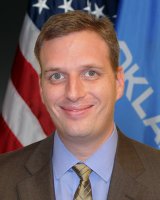November 19, 2018

National Public Safety Telecommunications Council
Join This Important Presentation on the Expanding Role of the COMU. On November 27, from 2:00–3:00 p.m. ET, the Interoperability Committee Will Host a Joint Session with the Broadband Emerging Technologies Working Group. Officials from the DHS Office of Emergency Communications will provide an update on proposed changes to the COMU [Communications Unit Leader] program, including expansion of responsibilities to manage broadband data and IT functions and ongoing discussions to elevate the COMU to a higher level in the ICS structure. This joint discussion, originally scheduled for October 23, was postponed when the speaker was deployed to assist with communications during Hurricane Michael in the Florida panhandle.
Conference Line U.S.: 510-227-1018; Conference ID: 446 1830#
Screen Share link: https://join.me/npstcsupport1
Screen Share link: https://join.me/npstcsupport1
NPSTC Filed Reply Comments on Metrom Rail LLC Request for Waiver of Part 15 Ultra-Wideband Rules for a Positive Train Control System. NPSTC's reply comments addressed a request by Metrom Rail, LLC to waive two Part 15 technical rules to enable deployment of its unlicensed ultra-wideband positive train control system in the 3 GHz to 5 GHz area, which overlaps the public safety 4.9 GHz band.
 The reply comments recognized the benefits of positive train control systems, but expressed concerns about potential interference to the 4.9 GHz band. NPSTC is not certain whether or not interference to public safety 4.9 GHz operations would occur as these UWB devices would be low power and deployed at relatively low heights trackside. Rather than opposing the waiver request, the reply comments recommend three conditions if the Commission grants the requested waivers. These conditions would require that a list of UWB deployment locations be maintained, that testing for potential interference to the 4.9 GHz band be conducted in initial UWB deployments in the Boston, Los Angeles, and New York metropolitan areas, and that a "stop buzzer" function with a named point of contact be created to address any interference that occurs.
The reply comments recognized the benefits of positive train control systems, but expressed concerns about potential interference to the 4.9 GHz band. NPSTC is not certain whether or not interference to public safety 4.9 GHz operations would occur as these UWB devices would be low power and deployed at relatively low heights trackside. Rather than opposing the waiver request, the reply comments recommend three conditions if the Commission grants the requested waivers. These conditions would require that a list of UWB deployment locations be maintained, that testing for potential interference to the 4.9 GHz band be conducted in initial UWB deployments in the Boston, Los Angeles, and New York metropolitan areas, and that a "stop buzzer" function with a named point of contact be created to address any interference that occurs.

IACP Supports Don't Break Up the T-Band Act. In a recent letter to Congress, the International Association of Chiefs of Police (IACP) expressed its support for H.R. 5085/S. 3347, the Don't Break Up the T-Band Act. Their letter stated, "... spectrum in the T-Band (470–512 MHz) is used by law enforcement and other public safety entities in and around eleven metropolitan areas of the United States to support critical public safety communications and provide regional interoperability among first responders. Unfortunately, Section 6103 of Public Law 112-96 (The Spectrum Act) directs the Federal Communications Commission (FCC) to begin auctioning the public safety T-Band spectrum for commercial use by February 22, 2021, and clear all public safety operations from the band within 2 years of auctions close (i.e., by early 2023)."
"Significantly, while the Spectrum Act does allow the auction revenue to be used to cover costs associated with relocation, the act does not specify any replacement spectrum or ensure auction revenues will be sufficient to fund the relocation. Given the importance of this issue and its potential impact on public safety, the National Public Safety and Telecommunication Council (NPSTC) concluded that loss of the T-Band spectrum resource would be particularly problematic for public safety in the Boston, Chicago, Los Angeles, New York, and Philadelphia metropolitan areas."
NPSTC Governing Board Member, Eddie Reyes, IACP, Will Represent NPSTC on the FCC's BDAC's Disaster Response and Recovery Working Group. The mission of the Broadband Deployment Advisory Committee (BDAC) is to provide advice and recommendations to the Commission on how to accelerate the deployment of high-speed Internet access. The BDAC's Disaster Response and Recovery Working Group is charged with making recommendations on measures that can be taken to improve resiliency of broadband infrastructure before a disaster occurs, strategies that can be used during the response to a disaster to minimize the downtime of broadband networks, and actions that can be taken to more quickly restore broadband infrastructure during disaster recovery. It will also develop best practices for coordination among wireless providers, backhaul providers, and power companies during and after a disaster.
 |
Welcome Matt Singleton: New Governing Board Alternate Representative for the National Association of State Technology Directors (NASTD). Matt Singleton, chief operations and accountability officer for the State of Oklahoma's Information Services Division, is charged with statewide IT operations, modernization of IT services, and enhancement of IT client experience. His most recent initiative, the unification of 111 IT organizations across the state, realbsized over $325M in cost-savings and was recently featured in the Wall Street Journal best-seller, "One Mission: How Leaders Build a Team of Teams" by Chris Fussell.
|
Join Us on Social Media
NPSTC Outreach News and Related Public Safety News are now available on NPSTC's blog.
Click on the orange icon above to check it out.
Click on the orange icon above to check it out.









